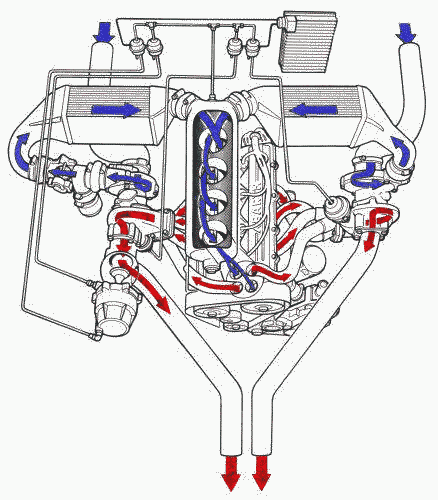
Thanks 747heavy. This was the engine for the still born Lancia ECV Group S Rally car, I believe.
The engine shown in the pic did not have a compressor and with modern variable geometry turbos would not need it. I wonder what kind of power such a triflux biturbo would do with modern technology and direct injection. 8,000 rpm does not sound that high. A pity that we do not have boost figures for that engine.Lancia announcement wrote:Fiat have patented a brand new cylinder head. As a twin turbocharged engine was being used, Fiat had to revise the layout of the cylinder head to improve the suitability for the set up. Normally, the inlet valves are on one side of the layout, exhaust valves on the other, but this makes a twin turbo engine difficult to produce. On the new unit, the four valves of each cylinder are laid out in a cross pattern with the inlet and exhaust valves alternated on each side of the cylinder head. An exhaust manifold can therefore be placed on each side of the engine with the inlet manifolds entering from the center, either independently or combined into one. The system is known as the double reverse flow and, as the intakes combine into one near the valve, leaving just three gas flows for each cylinder, the head has been christened the Triflux.
The system produces improved heat distribution in the cylinder head to even out the expansions that take place on a turbo unit, also helping to improve engine cooling. It is now possible to link a single central wastegate valve to the two exhaust manifolds and, if the latest variable geometry turbochargers are utilised, the wastegate can be eliminated altogether. The air that leaves the turbochargers is injected into the radiators or intercoolers before being passed on to the induction manifold and thence back into the cycle, while the compactness of the engine allowed the engineers much more freedom to plan the exhaust system to eliminate resonance problems encountered in more crowded systems. The twin KKK turbochargers can be linked in a modular turbocharging unit, with a single turbo being used at low revs to build up power and then, when the revolutions are right, the second turbo comes into play to take the power even higher. With such a unit, high torque is produced at low revs with no loss of maximum power and greatly reduced turbo lag. It is the logical step forward from the present system of twin power provisions employed by the S4 engine, where the supercharger deals with low revs, the turbo producing the top end performance.
LANCIA GROUPS RALLY CAR
Technical specification
EngineCentrally mounted, longitudinal with 4 cyl inline. 1795CC. Bore x stroke, 88.5mm x 71.5mm Triflux' double reverse flow cylinder head with 4 valves/cylinder and twin overhead camshafts. Compression ratio, 7.5:1. 600bhp @ 8000rpm.. 55mKg@5000rpm. Twin KKK (K26 type) turbochargers with individual intercoolers. Weber/Magnetti Marelli injection/ignition with electronically controlled turbocharging level. Dry sump lubrication with pressure and extraction pumps and air/oil radiators.
One other issue that has never been covered by FOTA/FiA is the question of inter cooling. It is currently forbidden in F1 but I think that for the sake of efficiency they will allow it for the new turbo engines. It would cercainly allow higher compression ratios than non inter cooled turbo charging.








